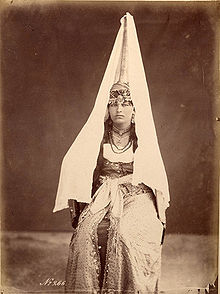The tantour (tantoor) is a form of cone-shaped women's headdress similar to the hennin, popular in the Levant during the nineteenth century, but seldom seen after 1850 outside of use as a folk costume.[1][2]


The tradition persisted longer in Lebanon among the Druze.[citation needed]
The tantour was held in place by ribbons tied around the head. A silk scarf was wound around the base with a white veil attached to the peak. The height and composition of the tantour were proportional to the wealth of its owner, with the most splendid tantours made of gold and reaching as high as thirty inches. Some were encrusted with gems and pearls.
The tantour was a customary gift presented to the bride by her husband on their wedding day.[3]
Gallery edit
-
Damascus fashion, illustration from the book Popular Costumes in Turkey, 1873
-
Lebanese fashion, illustration from the book Popular Costumes in Turkey, 1873
See also edit
- Hennin
- Kokoshnik
- Ochipok
- Labbadeh, traditional Lebanese men's headdress
- Pointed hat
- List of hats and headgear
References edit
- ^ "19th Century Lebanese Princess", Almashriq, NO: Hiof
- ^ "The Tantour or Shihabbiyeen". TRMKT. Retrieved 2010-08-16.
- ^ "Origin of Levantine Costumes". Almashriq. Hiof. Archived from the original on 2010-02-24. Retrieved 2010-08-16.